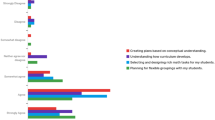The shortage of certified teachers in mathematics and science in Texas classrooms is a major concern and mirrors national tends. Dramatic increases in shortages of teachers have stimulated the design of new certification programs that recruit and place teachers in classrooms as quickly as possible (Texas Center for Educational Research, 1999). While maintaining several of the characteristics of traditional certification programs, the Math and Science Scholars (MASS) Program streamlines the certification process, supports preservice students through tuition remission and scholarships, and provides quality mentoring and early fiend experiences in K–12 classrooms with well-qualified teachers. The strategies in this model program are dramatically increasing the numbers of undergraduate majors in mathematics and science considering high school teaching as a career.


Similar content being viewed by others
References
Across the state, a teacher divide (2003). The Dallas Morning News, p. A1.
Bransford, J., Brown, A. L., & Cocking, R. R. (2000). How people learn: Brain, mind, experience, and school (expanded ed.). Washington, DC: National Academy Press.
Darling-Hammond (Ed.). (1994). Professional development schools: Schools for developing a profession. New York: Teachers College Press.
Herbert, K. S. (2004). Production and retention of beginning teachers from 1999 to 2003: A comparison of preparation routes. Preliminary report issued to the State Board for Educator Certification. Retrieved September 11, 2004, from http://www.sbec.state.tx.us/SBECOnline/reptdatarsrch/prerptprodretrvsd.pdf
Ingersoll, R. M. (2003). Turnover and shortages among science and mathematics teachers in the United States. In J. Rhoton, & P. Bowers (Eds.), Science teacher retention: Mentoring and renewal (pp. 1–12). Arlington, VA: National Science Teachers Association Press.
Luft, J. A., & Patterson, N. (2002). Bridging the gap: Supporting beginning science teachers. Journal of Science Teacher Education, 13, 267–282.
National Commission on Mathematics and Science Teaching for the 21st Century. (2000). Before it’s too late. Washington, DC: U.S. Department of Education.
National Research Council (2001). Educating teachers of science, mathematics, and technology: New practices for the new millennium. Washington, DC: National Academy Press.
Rhoton, J., & Bowers, P (Eds.). (2003). Science teacher retention: Mentoring and renewal. Arlington, VA: NSTA Press.
State Board for Educator Certification (1998). Who is teaching in the Texas public schools? Austin: State Board for Educator Certification, 14.
State Board for Educator Certification (2003). Who is teaching. Retrieved August 12, 2003, from http://www.sbec.state.tx.us/Reports/WhoIsTeaching/frm_Whois_ main.asp
Texas Center for Educational Research (1999). Texas teacher recruitment and retention study. Austin: Author.
Texas Education Code, The Texas Statutes (2003). § 21.050. Academic degree required for teaching certificate. Retrieved September 29, 2004, from http://www.capitol.state.tx.us/statutes/docs/ED/content/htm/ed.002.00. 000021.00.htm
U.S. Department of Education, Office of Policy Planning and Innovation. (2003). Meeting the highly qualified teachers challenge: The secretary’s second annual report on teacher quality. Washington, DC: U.S. Department of Education.
Author information
Authors and Affiliations
Appendix
Appendix
Dear New Student:
On behalf of the College of Science, I am delighted to welcome you to Texas A&M University. I am excited that you have decided to further your education through our College, an emerging leader among science programs with an active faculty equally dedicated to generating solutions to today’s problems and producing tomorrow’s leaders.
As one of the country’s premier science programs, we attract some of the best students from across the nation with a myriad of opportunities available through our many departments, centers and institutes. Specifically, you might be interested in one of our newest options for undergraduates: the Math and Science Scholars program.
As you may know, the need for secondary teachers is at an all-time high, particularly in the areas of mathematics and science. Currently, many districts award signing bonuses, and there is even pending state legislation to increase compensation to such professionals. As teachers ourselves, we feel strongly that there is no higher calling than this highly esteemed and noble profession.
In an effort to positively affect the future of mathematics and science education, we created the MASS program, which allows access to top faculty within the Colleges of Science and Education and Human Development. This program utilizes a field-based approach to mathematics and science education that features hands-on teaching strategies in local secondary classrooms with some of the area’s best master teachers. Students seeking certification graduate with the same number of hours as any other major and receive a degree in one of four areas of specialization: biology, chemistry, mathematics, or physics.
I urge you to consider participating in the MASS program by enrolling in the one-hour introductory course, TEFB 201 (Self-Directed Studies With Adolescents). As an added incentive, we will completely cover the costs of this one-hour course for the first 50 participants.
If you are a talented freshman who wants to explore the option of a future in teaching, even if it is secondary to the pursuit of professional or graduate school, I encourage you to enroll in TEFB 201 and alert your advisors this summer at your New Student Conference of your interest in teaching. The experience could be free and may provide valuable insight into another potential profession. Should you decide not to pursue teacher certification, that credit hour would be applied toward your free electives in any of our degree plans.
To learn more about the MASS program, please refer to the enclosed brochure or visit <http://mass.tamu.edu>. If you are interested in participating in the program, you may contact Jennifer Parrott, MASS Program Coordinator, at 979-862-1858 or by email at jparrott@science.tamu.edu. Please also feel free to contact me if you have any questions about this program or any other aspect of the College of Science. We look forward to meeting you this summer!
Sincerely,
Timothy P. Scott, Ph.D.
Associate Dean for Undergraduate Programs
About this article
Cite this article
Scott, T.P., Milam, J.L., Stuessy, C.L. et al. Math and Science Scholars (MASS) Program: A Model Program for the Recruitment and Retention of Preservice Mathematics and Science Teachers. J Sci Teacher Educ 17, 389–411 (2006). https://doi.org/10.1007/s10972-006-9026-3
Published:
Issue Date:
DOI: https://doi.org/10.1007/s10972-006-9026-3




